At BarBend, upper-body workouts are our bread and butter (but don’t get it twisted; we love a good leg day). From bench presses to barbell rows and everything in-between, our editorial staff is packed to the brim with expert trainers who won’t miss an opportunity to go to bat for our favorite muscle-building moves.
If you’re here, that’s probably exactly what you’re after — a comprehensive, expert-verified list of the best upper body exercises you can do, plus how to build them into grab-and-go workout routines. You’re in luck. Here are a dozen of our favorite upper-body exercises for muscle. strength, and much more:
12 Best Upper Body Exercises
- Overhead Press
- Bench Press
- Bent-Over Barbell Row
- Weighted Dip
- Chin-Up
- Push-Up
- Lat Pulldown
- Inverted Row
- Overhead Triceps Extension
- Landmine Press
- Farmer’s Carry
- Bicep Curls
What You Need for the Upper Body Workout
Some of these exercises are moves you can perform at home with little to no equipment. However, your upper body consists of many different muscles, and you can’t hit them all with pull-ups and push-ups.
If you want to use the exercises in this list, you’ll probably need access to a commercial gym (or a very well-furnished home gym). The main pieces of equipment you should have are:
- Barbell
- Weight Plates
- Dumbbells
- Adjustable Weight Bench
- Adjustable Cable Station
- Squat or Power Rack
Editor’s Note: The content on BarBend is meant to be informative in nature, but it should not be taken as medical advice. When starting a new training regimen and/or diet, it is always a good idea to consult a trusted medical professional. We are not a medical resource. The opinions and articles on this site are not intended for use as diagnosis, prevention, and/or treatment of health problems. They are not substitutes for consulting a qualified medical professional.
1. Overhead Press
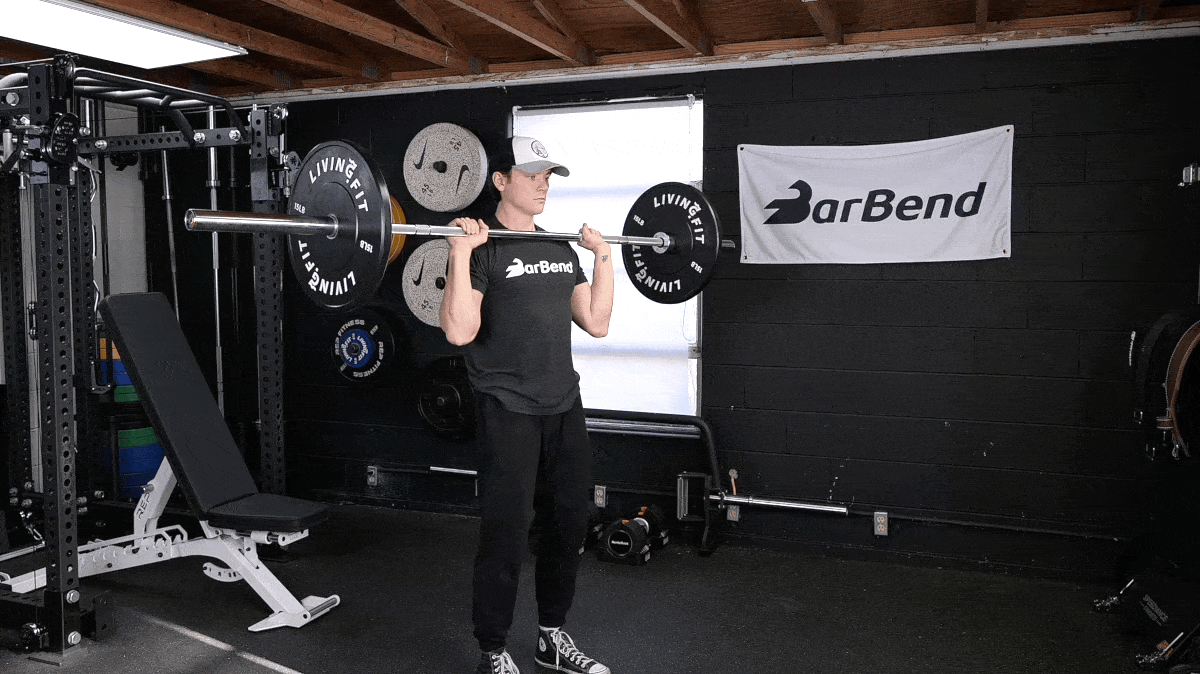
| Equipment Needed | Squat or power rack, barbell, weight plates, wrist wraps (optional) |
| Muscles Worked | Shoulders, triceps |
| Sets & Reps | 3-4 x 5-8 |
The strict press is one of the best shoulder exercises. We like it for its simplicity and functionality. If you can properly push a barbell over your head, you can do almost any other shoulder movement out there.
“Upper body strength movements, such as the bench press and overhead press, are essential for developing the pectoral, deltoid, and triceps muscles, contributing to overall upper body mass and power,” says BarBend Expert Gianna Masi.
You can use dumbbells, kettlebells, or a barbell for the strict press. Lifting a barbell does require more shoulder mobility, so if that’s something you’re lacking, start with dumbbells.
How To Do It
- Set a barbell in the rack at shoulder height. With your hands shoulder-width apart, grab the bar from underneath, letting it sit in your palms, and set it at the top of your chest.
- Tighten your core and push your chest out to create a strong base.
- Using only your upper body, move your chin out of the way and push the bar up in a straight line.
- Lock your elbows out at the top of the lift and slowly lower back to the starting position.
Modifications
- Make It Easier: Try an incline press instead. For some people, a direct overhead press requires mobility their shoulders may not have, but you can derive most of (if not all) the same benefits from an incline press as an overhead press.
- Make It Harder: Try a push press. This is essentially an overhead press with a leg drive. This allows slightly more weight while utilizing the coordination of the legs and core muscles to drive up into the bar..
2. Bench Press
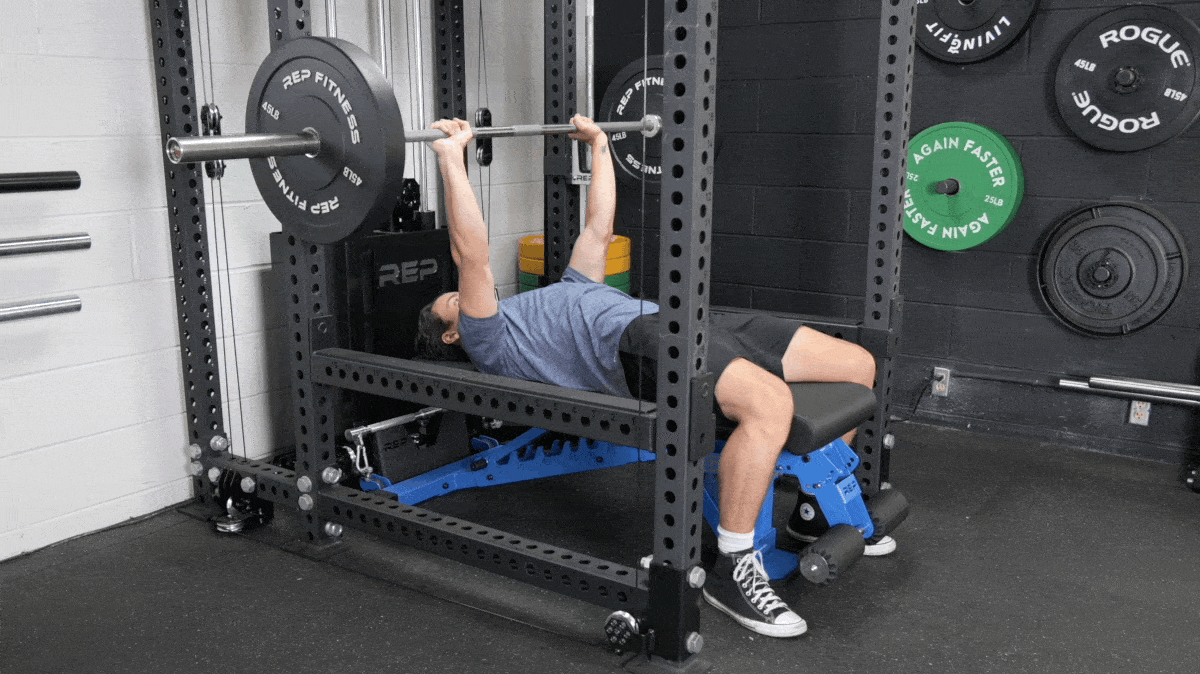
| Equipment Needed | Bench press station, barbell, weight plates, wrist wraps (optional) |
| Muscles Worked | Chest, shoulders, triceps |
| Sets & Reps | 3-4 x 6-10 |
The bench press and all its variations (incline, decline, close-grip, with dumbbells, or the floor press) is a movement that targets the chest, triceps, and shoulders. It is one of the best movements to build horizontal pressing strength.
Like most barbell exercises, it allows you to use a greater load than you could muster with kettlebells or dumbbells. Powerlifters should train the bench press routinely since it’s one of the three competition lifts alongside the squat and deadlift.
How To Do It
- Lie flat on your back on a bench and get your eyes directly underneath the barbell.
- Grip the bar with your hands wider than shoulder-width apart. Bring your feet closer to your glutes, push your feet back, and unrack the bar so that it’s over your chest.
- Lower the bar slowly to your chest as you breathe in and push your feet back.
- Arch your back slightly to push the barbell up until lockout.
Modifications
- Make It Easier: Try the floor press to limit your range of motion and add more stability.
- Make It Harder: Pause with the bar on your chest for two seconds on every rep.
3. Bent-Over Barbell Row
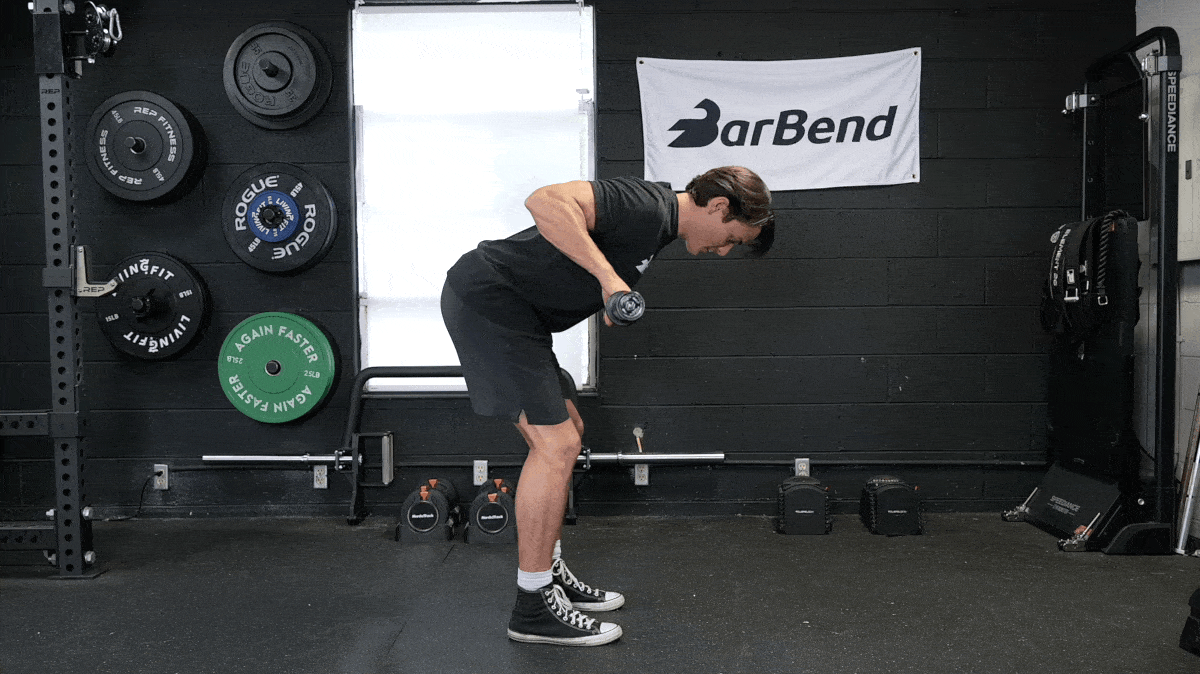
| Equipment Needed | Barbell, weight plates, lifting straps (optional), lifting belt (optional) |
| Muscles Worked | Lats, traps, lower back, biceps, core |
| Sets & Reps | 3 x 6-12 |
The bent-over row is a popular exercise since it strengthens and increases mass in the upper back and lats. It allows you to use the most weight relative to other rowing variations. Lifting heavier weights regularly with good form equals more muscle.
Because you’re in a hip hinge position, the bent-over row is the best lower back exercise that trains the lower back isometrically. A stronger lower back will help you brace and maintain a rigid torso when deadlifting and squatting.
Variations To Try: Dumbbell row, seal row
How To Do It
- Place a loaded barbell on the floor and stand with your feet slightly more than hip-width apart.
- Hinge down to the barbell and grab the barbell with a shoulder-width grip. Then, bring the barbell up to knee level with the back straight and torso bent at 45 degrees.
- Pull the barbell between your navel and sternum.
- Pause, then slowly lower the barbell back down and repeat.
Modifications
- Make It Easier: Lifting straps will allow you to practice your form without worrying about the bar slipping out of your hands.
- Make It Harder: Try pausing with the bar in contact with your stomach at the end of each rep.
4. Weighted Dip
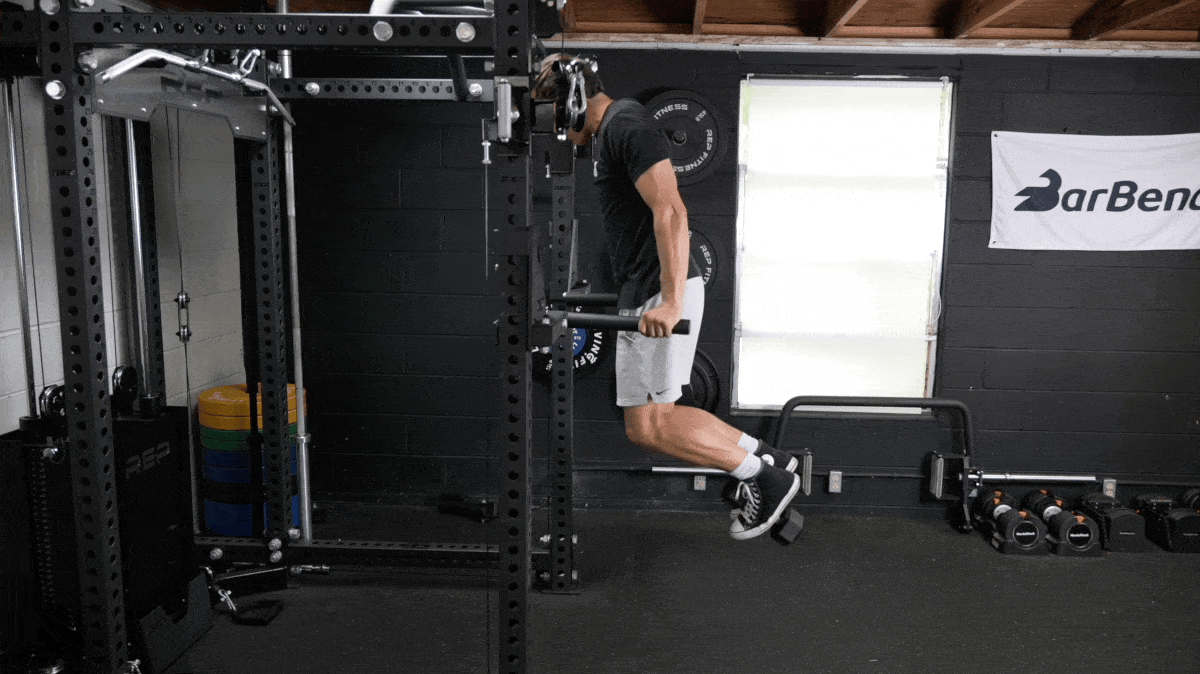
| Equipment Needed | Parallel bars, wrist wraps (optional), dip belt (optional) |
| Muscles Worked | Triceps, chest, shoulders |
| Sets & Reps | 3 x 8-12 |
Weighted dips allow you to simultaneously work your chest and triceps depending on the positioning of your body. Compared to most triceps exercises, the range of motion you achieve doing dips is longer, so it’s generally considered one of the best triceps exercises.
[Read More: Build a Titanic Torso with These Bodybuilding Chest & Back Workouts]
Suppose you can’t do weighted dips yet — no problem. Use your body weight until you build up your strength and endurance. Once you’re ready, add weight in small increments using a dipping belt.
How To Do It
- Either use a weight belt, or weighted vest, or hold a dumbbell between the legs for resistance.
- Squeeze the bars with each hand and lower yourself down until your elbows break 90 degrees.
- Still squeezing the bars, drive yourself upwards while maintaining a slight forward lean.
- When approaching lockout, flex the back of your triceps, pause for a second, and slowly lower down and repeat.
5. Chin-Up
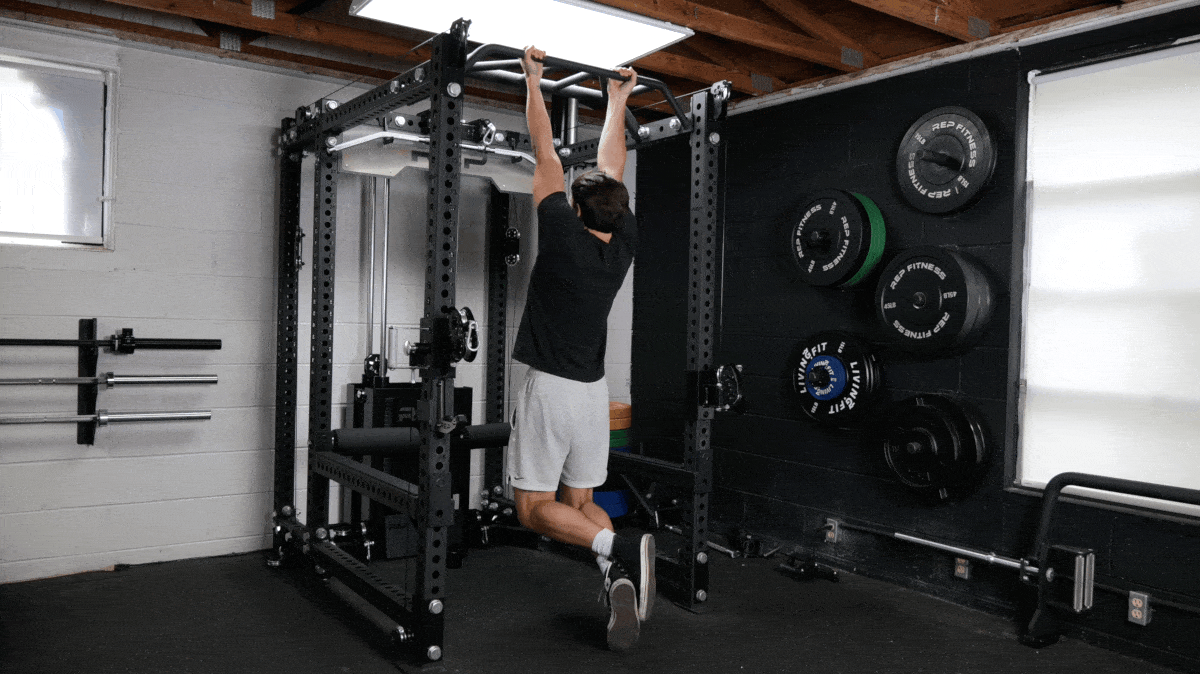
| Equipment Needed | Pull-up bar, dip belt (optional) |
| Muscles Worked | Lats, biceps, upper back |
| Sets & Reps | 3-4 x 10+ |
The chin-up requires a lot of prerequisite strength, stability, and mobility — but perhaps less so than the pull-up. In this way, the chin-up may be more accessible to beginners. If you’re still new to the movement, use resistance bands to assist you.
And if you’ve already mastered the chin-up, keeping them actively in your repertoire will help ensure continued back and biceps strength. You can even add pauses at various spots in your range of motion to increase time under tension and kickstart even more muscle growth.
Variations To Try: Single-arm, band-assisted, or kipping
How To Do It
- Grab hold of a pull-up bar with your palms facing you, a little closer than shoulder-width apart.
- Hang from the bar until you’re stable. Initiating the pull with your back, drive your elbows down toward your back packets.
- Pull yourself up until your chin clears the bar. Lower with control and repeat for reps.
Modifications
- Make It Easier: Do band-assisted or machine-assisted chin-ups if you can’t string together multiple unassisted reps.
- Make It Harder: Add weight by holding a dumbbell between your ankles or wearing a dip belt with plates attached.
6. Push-Up
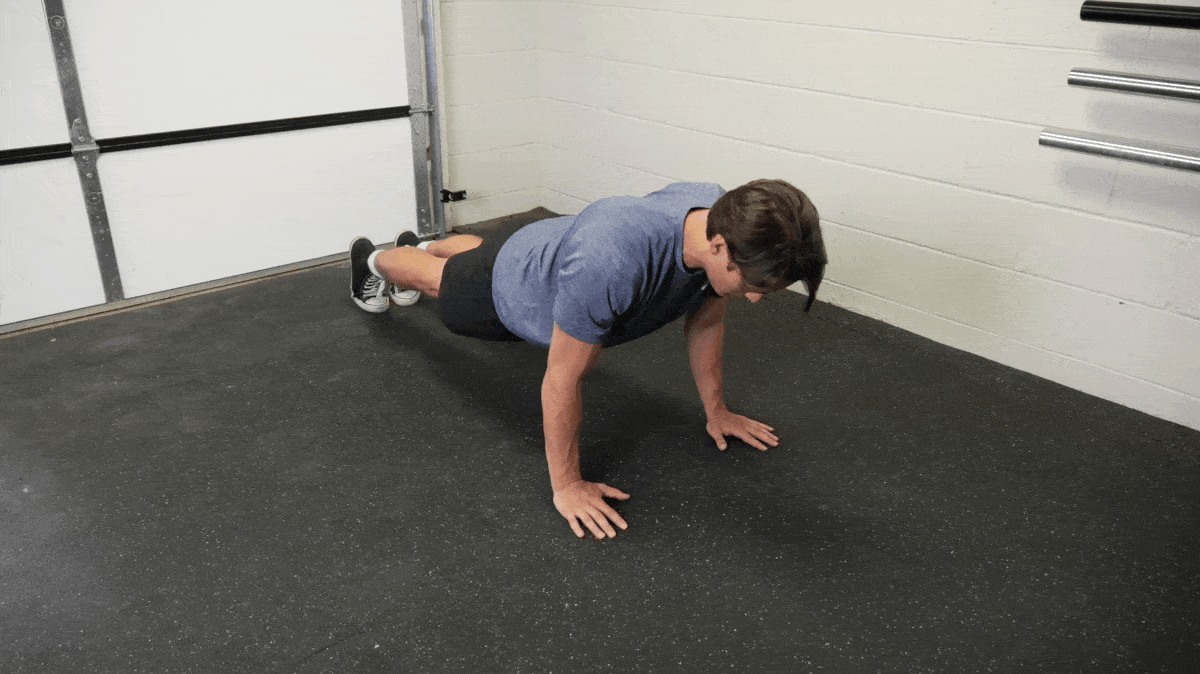
| Equipment Needed | Exercise mat (optional) |
| Muscles Worked | Chest, shoulders, triceps |
| Sets & Reps | 2-3 x 10-20 |
Ah, the push-up. It’s one of the best chest exercises, yet so many people struggle with push-ups or discard them altogether. But when done with good form and a full range of motion, this compound exercise activates multiple muscles in your upper body, such as your chest, shoulders, triceps, and abdominals.
Push-ups are a quick and effective way to build strength and require nothing but your body weight. (Though, you can add a weight vest or weight plate to make the movement more challenging.)
How To Do It
- Start in a plank position with your hands stacked underneath your shoulders, your back flat, and your core tight.
- Maintaining a straight line from your head to your heels, slowly lower your body to the floor by bending your elbows. Go as close to the ground as you can without losing tension.
- Press the floor away from your hands while maintaining a tight core to avoid dipping hips. Finish in the position you started in.
Modifications
- Make It Easier: You can do push-ups on your knees or perform incline push-ups to make the movement easier.
- Make It Harder: Try decline push-ups or bring your hands into a diamond position.
7. Lat Pulldown
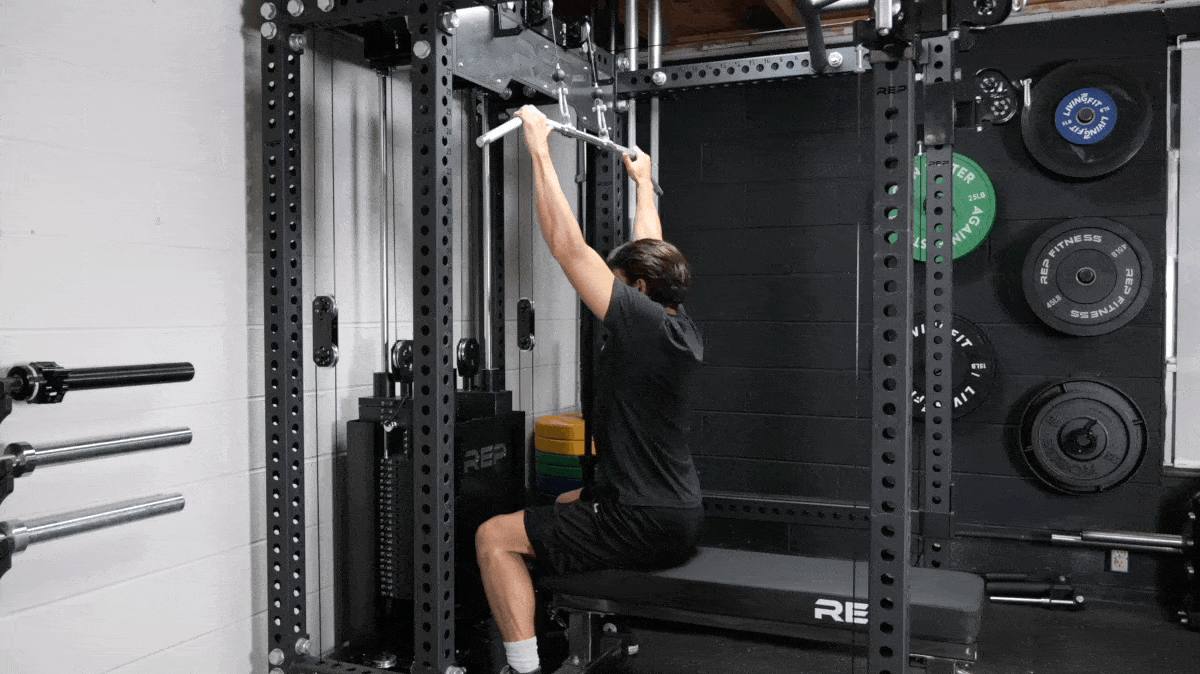
| Equipment Needed | Lat pulldown station, lifting straps (optional) |
| Muscles Worked | Lats, upper back, biceps |
| Sets & Reps | 2-3 x 10-15 |
If you’re looking to target the largest muscle in your back, we suggest the lat pulldown. This exercise allows for heavier weights and more reps because your body will generally be stabilized by the machine, making it one of the best upper body pull exercises you can do.
Variations To Try: Close-grip, single-arm
How To Do It
- Sit straddling the bench facing the lat pulldown machine, or tuck your thighs underneath the pad if you have access to one.
- Pull your shoulders away from your ears and use your back to pull the bar down to your upper chest. A slight lean back is okay if needed.
- Slowly extend the arms to your starting position.
8. Inverted Row

| Equipment Needed | Barbell, squat rack, or stable horizontal bar |
| Muscles Worked | Lats, biceps, upper back, core, glutes |
| Sets & Reps | 2-3 x 10+ |
Secret’s out; we adore the lat pulldown. This exercise does not get as much recognition as it should — mainly because it’s seen as a “Pull-Up Lite” — but it can benefit anyone from beginners to experienced athletes if you know how to use it.
Although underrated, there are plenty of benefits to the inverted row — it’s scalable, can be done almost anywhere, and taxes the back muscles without loading the lower back.
How To Do It
- Set a barbell at waist height in a power rack.
- Get under the bar and grip it slightly wider shoulder-width apart with your palms facing away from your head.
- Extend your arms and extend your legs, so your body is in a straight line from your head to your heels.
- Keeping that straight line, pull your body up to the bar until your chest reaches it, then slowly lower back to your starting position.
Modifications
- Make It Easier: Set the bar up a bit higher so your body is at a steeper incline.
- Make It Harder: Balance a weight plate across your lap to add resistance.
9. Overhead Triceps Extension

| Equipment Needed | Adjustable cable station, attachment of choice |
| Muscles Worked | Triceps |
| Sets & Reps | 2 x 12-15 |
If you want bigger arms, we have a pro tip — the triceps make up roughly two-thirds of your upper arm compared to your biceps. They steal the gun show more than you think.
[Read More: The Big Guide to Muscle Hypertrophy]
“Placing the triceps overhead will put them into a fully stretched position, which will help maximize stimulating strength and hypertrophy even further then a traditional tricep extension,” Masi says. “Plus, this will be a great stretch on the shoulder joint, assisting with the overhead position.”
Variations To Try: Single-arm, underhand
How To Do It
- Place a dumbbell in a diamond grip (make a diamond with your hands and place the bottom of the weight plate in between) and hold it overhead with your arms fully extended.
- Tighten your core, relax your shoulders, and keep your elbows tight to your head as you begin to bend your arms. Stop bending when your arms have made a 90-degree angle.
- Press back up to your starting position.
Modifications
- Make It Easier: Most people tend to find a single-hand rope attachment more comfortable to use than a straight or cambered bar.
- Make It Harder: Try pausing in the stretched position on each repetition.
10. Landmine Press
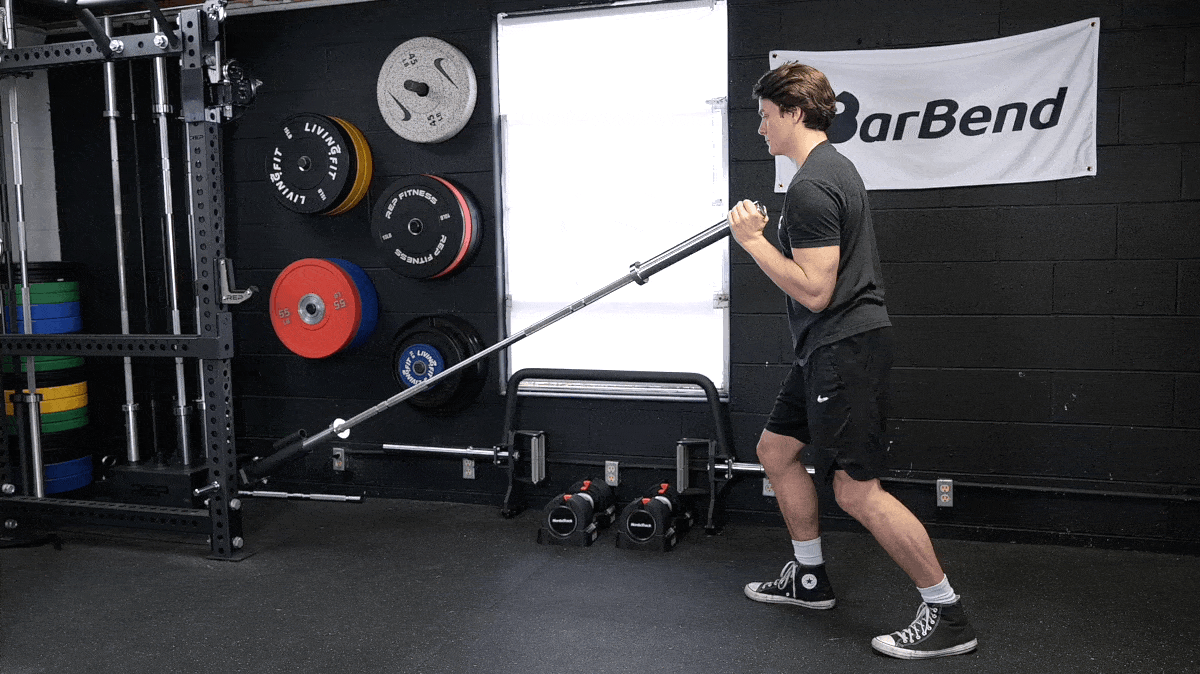
| Equipment Needed | Landmine attachment, barbell, weight plates |
| Muscles Worked | Triceps, shoulders, core |
| Sets & Reps | 2 x 12-15 |
The landmine press is less intense than the standard shoulder press or overhead press since it does not require as much shoulder flexion (due to the angled pressing path).
[Read More: The Best Online Workout Programs For Coaching, Cardio, Value, And More]
However, that doesn’t make this exercise any easier, and it’s a great way to target your upper body without lifting too heavy.
How To Do It
- Set up a barbell in a landmine base or, if you don’t have one, the corner of a wall. If performing the movement with one arm, grab the barbell at the top with one hand and hold it on the side you’re pressing from. If performing the move with both hands, grip the barbell and hold it in the middle of your chest.
- Press the barbell straight forward until your arm(s) are fully extended.
- Slowly lower the bar back to your starting position.
Modifications
- Make It Easier: You can do this move in a full or half-kneeling position instead of standing up.
- Make It Harder: Try this exercise with a narrow staggered stance to challenge your balance.
11. Farmer’s Carry

| Equipment Needed | Dumbbells, kettlebells, or trap bar frame |
| Muscles Worked | Traps, upper back, lower back, core |
| Sets & Reps | 2 x 30 seconds |
Heavy carries are a great way to build a bigger and more durable upper body. Gripping a heavy object taxes the muscles in the upper back, traps, and forearms, making this upper-body exercise with dumbbells a strength-boosting move that also bolsters your endurance.
“Make sure to actually load these! Most people in the gym are using grocery bag type loads. We are trying to push well past that with these,” Masi notes. “Legendary strength and conditioning coach Dan John has certain standards for these — half your body weight in each hand for 20-40 meters. If you’re really a beast he says you should be able to do that same distance with bodyweight in each hand.”
How To Do It
- Grab a pair of heavy dumbbells from the rack, grip them tightly, and stand tall by keeping your shoulders down and chest up.
- Walk slowly and deliberately in a straight line, placing one foot in front of the other for the required distance, and then set the weight down carefully.
12. Bicep Curls
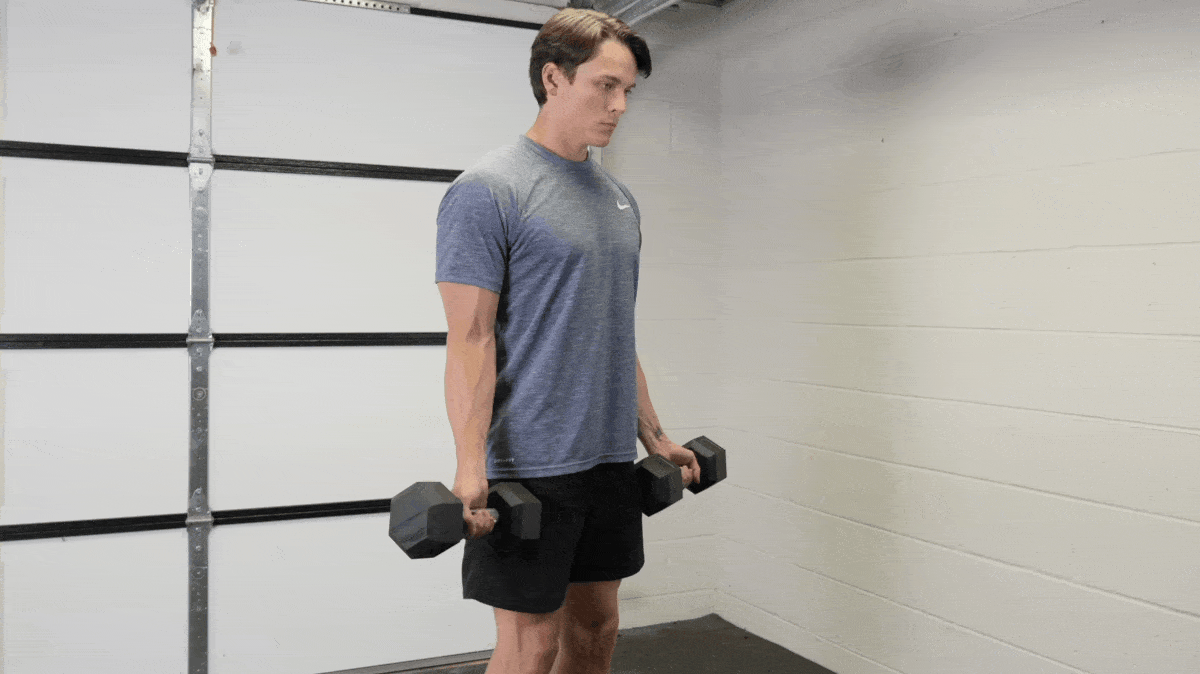
| Equipment Needed | Dumbbells or barbell |
| Muscles Worked | Biceps |
| Sets & Reps | 3 x 8-12 |
We love biceps just as much as you do — this isolation exercise is, basically, the only way to zero in on your biceps without involving other supporting muscles, making it one of the best biceps exercises. There are dozens of biceps curl variations out there, and they all accomplish mostly the same thing. If you’re new to curls, we think bicep curls are a phenomenal upper body exercise with dumbbells.
Variations To Try: Cheat curl, reverse curl, incline dumbbell curl, Zottman curl
How To Do It
- Stand upright while holding a dumbbell in each hand.
- Rotate your arms so your palms are pointed forward.
- Without moving your upper arms, bend at the elbows and curl the weights up until your forearm is at least parallel to the floor.
5 Upper Body Workouts to Incorporate
The best upper body workouts are the ones that integrate push and pull movements to keep your body balanced in terms of both strength and muscle growth. Here are some of the upper body workouts you can incorporate into your overall program, depending on your specific fitness goals and aspects of your identity.
Upper Body Warm-Up
All good workouts start with an appropriate warm-up. Even the best upper body workout out there may not go according to plan if you don’t prepare properly. For most people, the shoulders require a bit of attention and priming before you dive into heavy lifting. Try this shoulder-focused warm-up routine:
- Cardio: Do 5 to 10 minutes on the treadmill, elliptical, bicycle, or stair stepper to get your heart rate up.
- Shoulder Dislocations: Grab a PVC pipe or dowel and hold it overhead with a wide grip, then slowly swing the object forward and backward in an arc around your torso.
- Face Pulls: Grab a cable station or resistance band and perform 15-20 face pulls, driving your elbows high and behind your torso to engage your upper back.
- Scapular Push-Ups: Assume a push-up position, but instead of bending your elbows, lift and lower your torso a few inches by pushing solely with your shoulders and allowing them to move.
Upper Body Workout for Muscle Growth
Building muscle is all about using the tools at your disposal — we mean your exercises of choice — to create as much muscle fatigue and strain as possible. To that end, we’re prioritizing exercises that have simple, stable techniques. We also want to target all major muscle groups in your upper body as efficiently as possible.
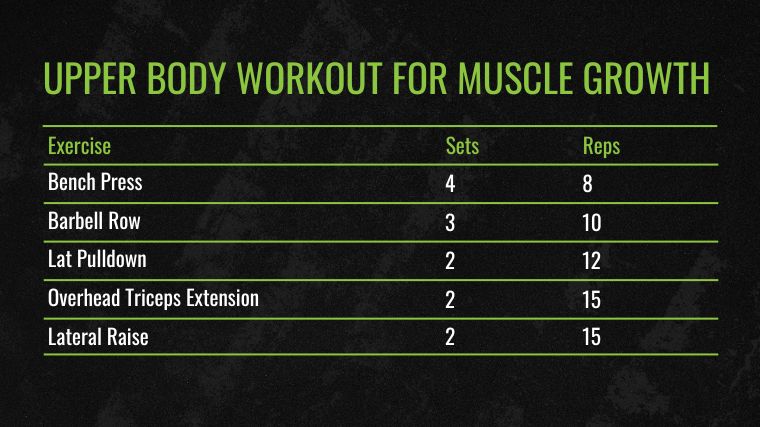
[Read More: What Are Workout Splits? Top 3 Most Effective Routines]
- Bench Press: 4 x 8
- Barbell Row: 3 x 10
- Lat Pulldown: 2 x 12
- Overhead Triceps Extension: 2 x 15
- Lateral Raise: 2 x 15
Upper Body Workout for Strength
To get strong, you need to focus on performing fewer reps with more weight, one exercise at a time. This low-rep, heavy-weight style of training forces muscles to exert maximal force, recruiting the more explosive type II muscle fibers needed to lift heavier weights.
Perform this workout once per week. Be sure to get a lot of rest between sessions — this is a taxing training session. Perform all the sets for each movement before moving onto the next exercise. Also, do not cut your rest time short. Rest three to five minutes between sets for most of these.

- Bench Press: 3 x 5
- Barbell Row: 3 x 8
- Chin-Up: 2 x AMRAP
- Farmer’s Carry: 4 x 20 paces
Upper Body Workout for Men
People of all genders can follow the same workout routines. That said, cis men may have a higher ratio of Type-II, fast-twitch muscle fibers. (1) To play to your strengths and beef up your pecs, shoulders, and arms in the process, give this one a go:
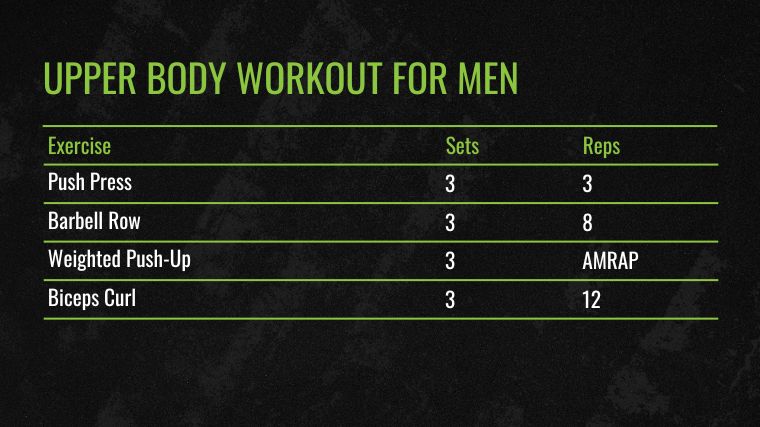
[Read More: Get Freakishly Strong With the 5×5 Workout Program]
- Push Press: 3 x 3
- Barbell Row: 3 x 8
- Weighted Push-Up: 3 x AMRAP
- Biceps Curl: 3 x 12
Upper Body Workout for Women
Women can perform the same strength training workouts as anyone else. That said, some studies have shown that female athletes respond slightly better to higher-repetition training. (2) We can modify a standard upper body workout to emphasize those advantages. Here’s an example:
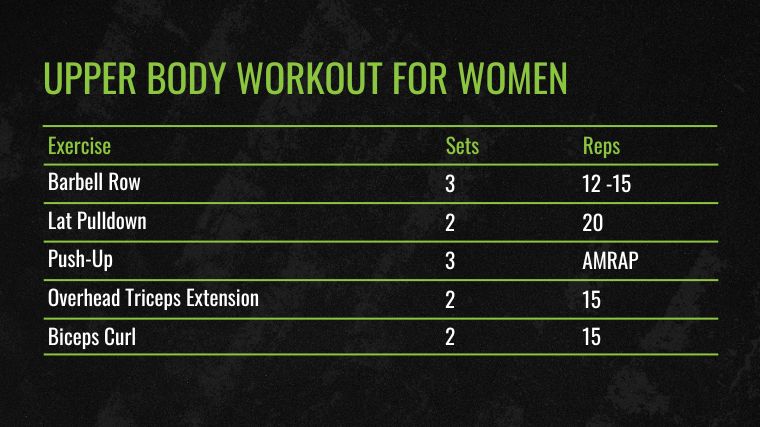
- Barbell Row: 3 x 12-15
- Lat Pulldown: 2 x 20
- Push-Up: 3 x AMRAP
- Overhead Triceps Extension: 2 x 15
- Biceps Curl: 2 x 15
Bodyweight Upper Body Workout
You don’t need weights to see results (though owning dumbbells, kettlebells, weight plates, a weight bench, and a barbell doesn’t hurt). Your body weight is a useful tool for combating gravity to produce muscle- and strength-building tension. Workouts without weights are also inherently more joint-friendly since there’s no external load pressing down on your spine, knees, and/or elbows.
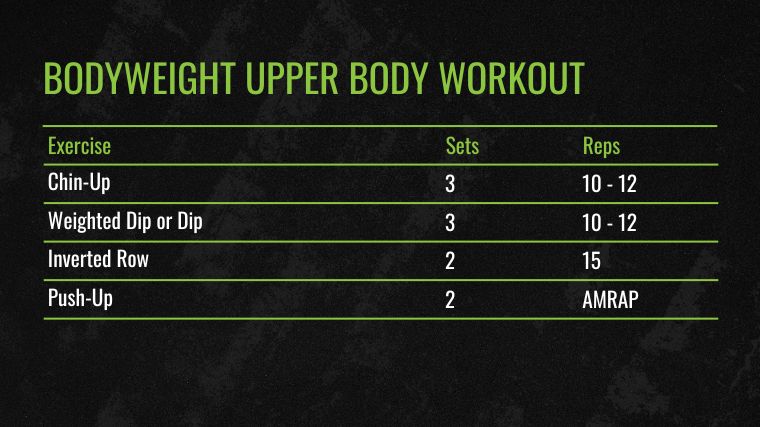
- Chin-Up: 3 x 10-12
- Weighted Dip or Dip: 3 x 10-12
- Inverted Row: 2 x 15
- Push-Up: 2 x AMRAP
Benefits of Training Your Upper Body
Aside from getting the V-taper, there are plenty of benefits to training your upper body. When you are pushing, pulling, or hinging with weights or just your body weight, exercises help you perform tasks in your daily life. They improve mobility and flexibility, which can help to reduce your risk of injury.
Reduced Risk of Injury
With a stronger upper body comes more stability. Every day you are most likely pushing and pulling moderate to heavy objects, whether opening a door or moving furniture. Maintaining muscle mass is especially important as you age because you lose muscle as you get older.
Research suggests that muscle mass decreases about three to eight percent per decade after you pass 30 years old, so it’s important to continue to load your muscles. (3)
Improve Other Areas of Training
A strong upper body is not only important for better shoulder presses but is also beneficial in other areas such as squats or deadlifts. Pulling a heavy barbell when deadlifting activates your biceps and back muscles.
[Read More: The Best Full-Body Bodybuilding Workout for Beginner to Advanced Lifters]
The stronger these muscles, the more weight you can lift. When squatting, the core muscles are engaged, and the stronger these are, the more you can lift properly, and manage the risk of injury.
Build a Strong Upper Body
It’s not just about developing other areas of your training life. By developing a strong, powerful upper body, you’ll be able to become more competitive at any strength sport. Whether you’re trying to develop an X-frame for your next bodybuilding show or boost your Total in weightlifting, you’ll need to train your upper body extensively to make it happen.
Muscles of the Upper Body
Below are some of the larger muscle groups of the upper body targeted and trained by these upper body mass-building exercises.
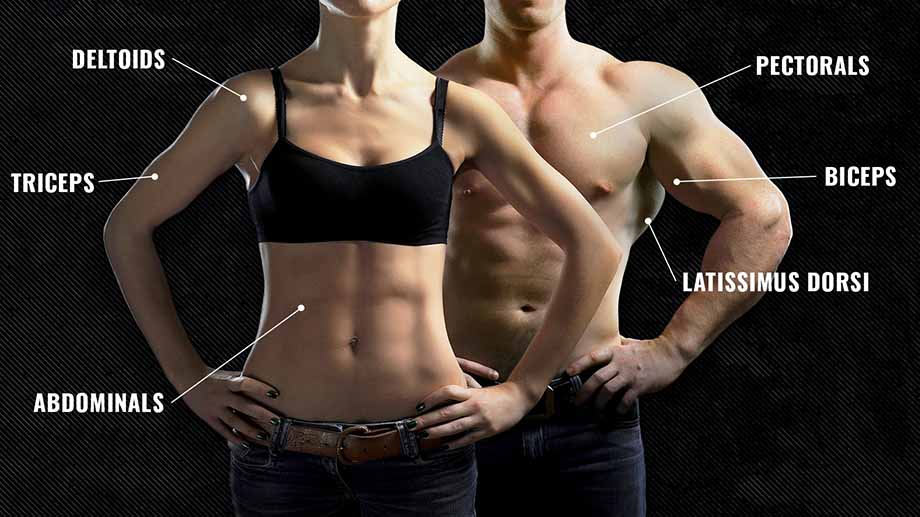
Latissimus Dorsi (Back)
The latissimus dorsi, also known as the lats, is a large muscle group that runs across the entire posterior of the torso. The back is the key to lifting heavier, gaining size, and improving performance.
[Read More: The Ultimate 10-Week Powerbuilding Workout Routine for Mass and Strength]
Along with the chest muscles, these muscles help posture and spine stability.
Pectorals (Chest)
The pectoral muscles (pectoralis major and minor) are developed by most horizontal pressing movements like the bench press (and the wide array of variations), push-ups, and dips. It’s important to keep these muscles strong because it helps with overall upper body strength and, along with the back muscles, helps prevent bad posture.
Deltoids (Shoulders)
The shoulder area comprises the deltoids and posterior shoulder complex/stabilizers (trapezius, scapular shoulder blades, and rhomboids). Vertical pressing movements like push presses and shoulder press variations are great movements for shoulder hypertrophy.
Triceps
The triceps are a smaller muscle group than the back and chest and serve an important role in aiding in pressing movements. They are also more responsible for arm mass.
Biceps
The biceps run along the anterior part of the arm and are responsible for elbow flexion and aiding in pulling movements like rows, pull-ups, carries, and deadlifts.
More Upper Body Training Tips
Now that you have a handle on the best upper body exercises to strengthen your chest, triceps, shoulders, back, and biceps, you can also check out these other helpful training articles for strength, power, and fitness athletes.
- The Best Upper Body Landmine Exercises for Building Strength and Mass
- The Best Neck Stretches to Improve Your Pulls and Overhead Lifts
- 5 Bench Press Programs to Build a Bigger, Stronger Chest
Frequently Asked Questions
How often should I train the upper body?
Your upper body is a collection of many different muscles that work together. As such, you’re likely to experience a lot of fatigue if you try to train your upper body too often. Aim for two upper body workouts per week.
What is the best upper body workout routine?
A well-designed upper body workout will contain both “push” and “pull” exercises, and also incorporate a variety of different equipment to challenge your body in unique ways.
References
- Oranchuk DJ, Storey AG, Nelson AR, Cronin JB. Isometric training and long-term adaptations: Effects of muscle length, intensity, and intent: A systematic review. Scand J Med Sci Sports. 2019 Apr;29(4):484-503.
- Nuckols, G. (2023a, July 31). Sex differences in training and metabolism. Stronger by Science.
- Fujita, Satoshi, Nazemi, Reza, & Volpi, Elena. Muscle Tissue Changes with Aging (2004). PubMed. 7(4)
Featured image: Makism Toome / Shutterstock